Pixar Movies RANKED
- Jake Zall
- Aug 10, 2020
- 29 min read
Updated: Jan 5, 2021
SPOILERS AHEAD FOR ALL PIXAR MOVIES
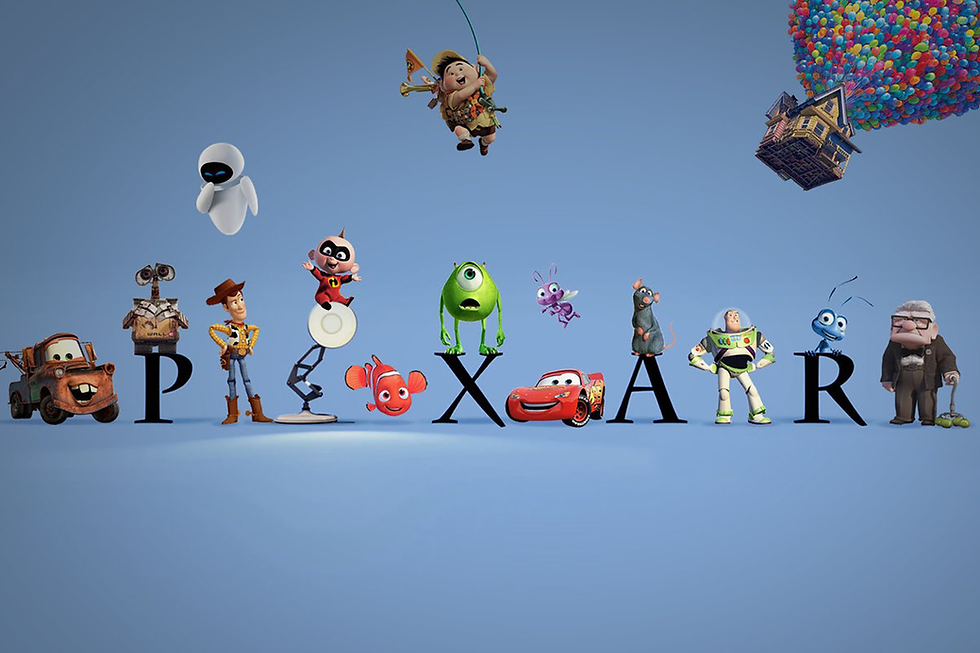
There are few film studios that have managed to raise the bar for an entire subset of movies. There are even fewer studios that have completely redefined the bar. And then there are the handful that have subverted their genre entirely to create their own bar. When it comes to animated movies, Pixar can 100% take credit for all three. In years past, not only has Pixar pioneered full length computer animated movies and re-popularized animated shorts, but an argument could be made that they were instrumental in introducing a newfound respect for animated movies in comparison to live action.
Pixar showed the world that computer animation could be just as if not even more compelling, emotional, and impactful than any other genre. They became known for their instantly likable characters, tear-jerking emotional arcs, visual beauty, and deep themes and motifs that stretch beyond the stereotypical “kids film”. This wave of uniquely creative films led to big-time recognition from the academy awards including two of the only three animated nominations for best picture. In general, people of all ages would agree that Pixar’s films are more than just some of the best animated films of all time, but they’re simply some of the greatest movies of all time.
All that being said, Pixar has certainly set a gold standard for themselves, making most of their 22 films very difficult to rank. However, with Onward having blessed our Disney+ accounts during quarantine, and 4 more months before the next Pixar release (Soul), now seems like the perfect opportunity to dive in deep and look at where each Pixar movie stacks up.
22. Cars 2

If one word could be used to describe Cars 2 it is...exhausting. This movie not only disappoints as a Cars sequel but it will make you scratch your head as to how it was made in the first place. Pixar movies have been described as insightful, genuine, and funny. The studio as a whole is considered to be a leader in the field of animated movies, paving the way for others. Well, Cars 2 lives up to none of these things. It’s completely devoid of that homey classic American vibe that made the first film a charmer and the story doesn’t seem to build upon anything layed out in the original. They even dismiss major emotional beats such as the passing of Lightning McQueen’s mentor Doc Hudson. Plus, it’s overstuffed with bright colors, lazy jokes, a ridiculous spy plot overlay, a silly twist and way way way way too much Mater; further solidifying it as a flashy movie to excite little kids and sell toys. Seriously, it’s a wonder who thought a franchise about a talking racecar and a small Western town needed to be extended with a secret agent Mater movie. This is a perfect example of how focusing too much on the comic relief character, and not waiting for a worthy script can be a bad idea. It’s also probably the only movie on this list that is objectively bad.
21. Cars 3

After the confusing and equally disappointing nature of Cars 2, it was hard to see where the future of the Cars franchise could be headed. However, regardless of its many merchandising opportunities, Pixar executives seem to really care about the world of Cars and must have realized that they led the story astray in the previous sequel. Cars 3 thus acts largely as an overcorrection to return the franchise to its roots and deliver a conclusion that fans of the original deserved. Ironically though, the main hindrance to this third Cars is that it simplifies itself so much to focus on being an emotional ending rather than a good movie on its own. Don’t get me wrong, it does a good job of driving the focus back onto Lightning McQueen so he can reconcile his own legacy with his insecurities. Yet much like the first Cars movie, it’s not really something we haven’t seen before. There’s plenty of movies about athletes ending on their own terms while newcomers pave the way of the future, but again it’s got heart. Cruz Ramirez is a great new addition to breathe life into the franchise and touch on gender inequality. Plus, the theme of rising technology and data was a nice touch to reflect upon our own society’s future. However, the film isn’t saying much else that wasn’t predictable or familiar upon first viewing. Probably the best thing about this final chapter is that the filmmakers fix their mistake of dismissing one of the best Pixar mentor figures: Doc Hudson. Doc was nothing short of integral to the people of Radiator Springs and the development of Lightning’s arc. Why Cars 2 dismissed his death I have no idea, but he deserved every bit of tribute he received in Cars 3.
20. The Good Dinosaur
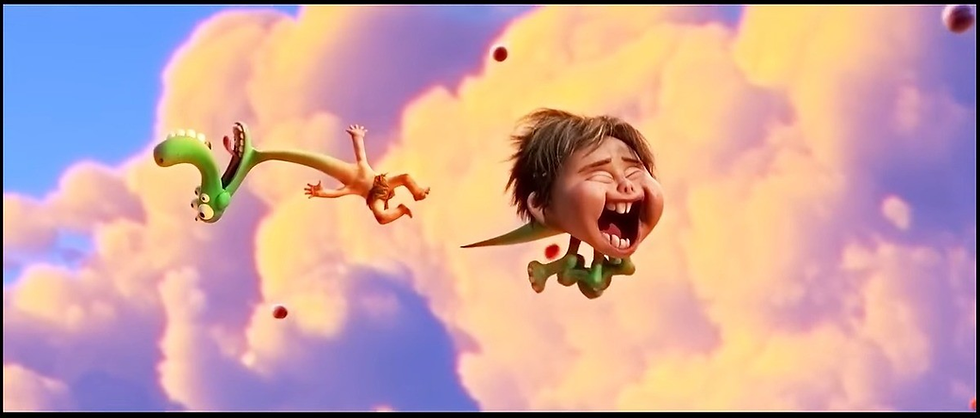
Normally when you mention The Good Dinosaur, nobody seems to remember that it even exists. It’s likely that this movie was overshadowed by the much more impressive Inside Out, which was also released in 2015. However, The Good Dinosaur definitely gets too much of a bad rap. The film is charming and pleasantly kills an hour and 40 minutes of time. The animation is stunning as usual and the emotional gut punch early in the film will give you serious Lion King PTSD (RIP Mufasa). However, something just doesn’t click in the execution of what was marketed as a prime Pixar premise.
Most of the marketing suggested that the story would answer the question, “what if the meteor that killed the dinosaurs never hit Earth?”. Although the plot loosely touches on this with some quirky talking dinosaurs, the side of the neanderthalic humans who coexist with the dinosaurs is barely explored. Main characters Arlo and Spot are cute, but within them lies a missed opportunity for Pixar to say something truly meaningful about evolution and humanity. Instead, Arlo’s story is a simple one of finding bravery, strength and maturity. Enjoyable? Sure. Up to Pixar’s normal standard? Not really. Let’s not even touch on the weird acid trip scene.
19. Brave
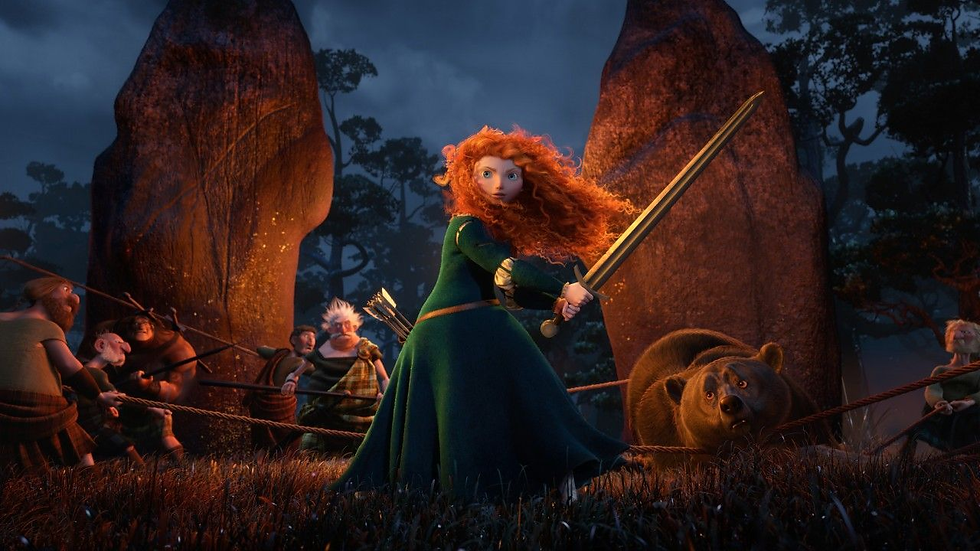
Before Pixar embarked on a full blown cultural escapade in Coco, they tested the waters with Brave. One thing the film nails is the cultural atmosphere. The kingdom of DunBroch showcases the beautifully soothing natural landscapes that Scotland is famous for. The castle feels warm and inviting in a Winterfell kind of way, and not to mention those curly locks of red hair look so real you could almost feel them. The decision to root the time period in 10th century Scotland, however, causes the movie to steer into more generic fantasy territory. Essentially, we’re left with a very by-the-numbers princess coming of age story (with some bears thrown in). Merida is surely a strong and powerful female character for girls to look up to, and the emotional journey that she takes with her mother transformed into a bear is enjoyable and heartwarming. Nonetheless, the resolution doesn’t feel like anything we haven’t seen before in the likes of Jasmine from Aladdin or Elsa from Frozen. It’s a decent watch but it just doesn’t give off that Pixar-y feeling that most of the other movies on this list do.
18. Cars

Sadly the Cars trilogy meets its end at rank 17. By many, Cars is considered to be classic Pixar, and by many standards it is. The premise is fun (although clearly aimed at a younger audience), and it’s another interesting world for Pixar to dive in and sprinkle various Pixarisms into. Plot wise, however, is where the movie thins out and becomes more of a simple kids movie. Lightning McQueen is your typical jerky hot-shot who becomes more selfless after a few days away from fame.
Where Cars really shines is the loveable small town group dynamic that is the residents of Radiator Springs. There’s just something about a cute off-the-beaten-path town that feels homey and nostalgic, and the animators really nailed this. It’s got a classic American almost Rocky vibe to it which makes it a sort-of comforting movie. Unfortunately, it just isn’t enough to bulk the plot up to usual Pixar creativity. If the writers delved more into the subplot about interstate highways harming the small businesses of Radiator Springs, we might have had another stroke of genius in the Pixar library. But as it stands, Cars is a simple, colorful story that younger generations will likely have more of an attachment to than others.
17. Monsters University

Twelve years after our heartstrings were tugged by Sully and Boo’s reunion at the end of Monsters Inc., Pixar brought us back to Monstropolis for their first prequel. Prequels this far from the original’s release are notorious for being labeled as cash grabs. But Monsters University does more than riff on the first film. Not to say that it’s anything revolutionary; the plot is essentially Revenge of the Nerds with monsters. But the movie sure does have fun with this premise using the fraternity scare games competition.
Mike and Sully are arguably one of the best Pixar duos, maybe only second to Woody and Buzz; so it’s a joy to spend more time with them and build upon their friendship. Even though it’s obvious that the story is a little forced, the lesson of the film kind of ends up being relatable. You can try your best to force your dreams to come true, but sometimes it’s not meant to be and you can live out your passion in an unexpected way. A more bittersweet theme for sure, but it works. So while it is entertaining, it’s far below its predecessor’s creatively. Plus, some continuity errors will make you tilt your head in confusion. It does have its moments such as the awesome climactic scene in the human world, but it’s nothing compared to the door chase scene. Overall, this one is good but a little unnecessary.
16. A Bug’s Life
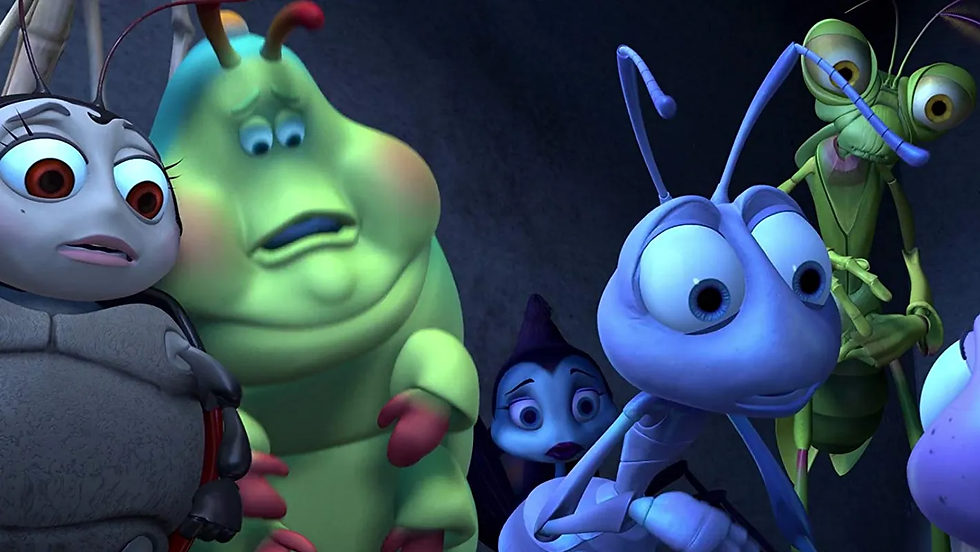
Pixar’s second theatrical outing was under a lot of pressure after the mind-blowing success of Toy Story. Obviously that’s a bit of a hard movie to follow, but A Bug’s Life was another solid addition to the foundation that has built Pixar into what it is today. The humor holds up because this movie is still really funny; again solidifying Pixar’s trademark humor that appeals to all ages. While the animation may not hold up as well today, it was revolutionary for its time. All the typical Pixar quirks are there, the circus bugs are such a great cast of characters, the bug city contains so many subtle jokes, and Hopper is undoubtedly a classic Pixar villain. Other than that, there isn’t a whole lot that is amazingly defining in terms of plot. This movie is so lovable, but if you strip away the nostalgia and try to stack this one up against the higher films on this ranking, it just doesn’t quite match up.
15. Incredibles 2
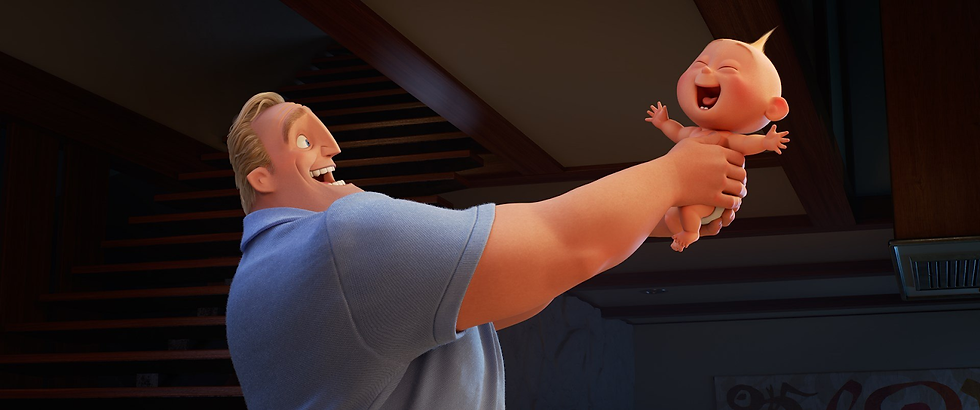
The Incredibles is probably one of the best examples of a franchise that was plagued by waiting too long. After 14 years, we finally got a follow-up adventure with the Parr family. It’s totally understandable that director Brad Bird wanted to wait for a script that felt natural. The potential was there for sure. In turn, the delay allowed for advancements in animation that perfectly highlight the style and aesthetic of The Incredibles and improve upon the action immensely. Truthfully, this contains some of the most enjoyable action scenes of any superhero movie; and the focus on Elasti-girl was cool to flip the family dynamic upside down from the original. So upon first viewing, it’s a fun movie. But if you really think about it, what is Incredibles 2 truly saying that is much different than the first one? I’d bet that if this came out years earlier, the reception might be different, but why take all this time to release something so similar? Regardless, it’s an exciting, funny, fast-paced sequel that fans of the original will like; but one thing’s for sure, Syndrome over ScreenSlaver anyday.
14. Onward
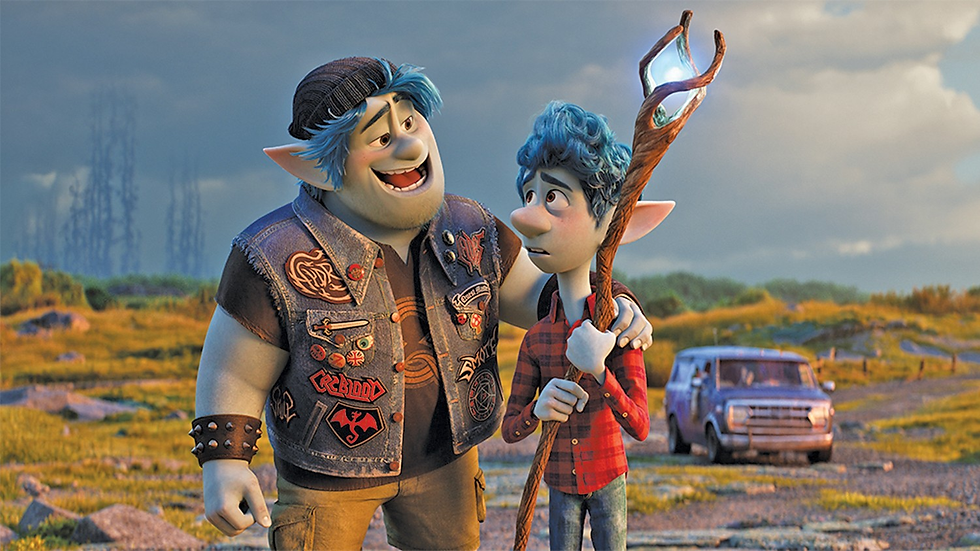
Onward had so much promise to start. Tom Holland, Chris Pratt, Julia Louis-Dreyfus and Octavia Spencer all together are nothing short of an all-star cast. Combine that with a delightfully weird premise of two brothers who accidentally bring back only the lower half of their dead dad’s body, and this had all the signs of a new Pixar classic. Although you’d be correct in saying that a world of trolls and fairies and magic is a bit of a generic (not to mention played out) idea, the filmmakers make it their own. This movie has a lot of heart, especially with what they put into Ian and Barley’s relationship. Just as Frozen is Disney’s sisterhood story, Ian and Barley make Onward Disney’s definitive brotherhood movie.
Those who have a brother of their own will find Onward refreshing, relatable and immensely touching (it helps when you have Tom Holland and Chris Pratt voicing the brothers). The larger themes of fatherhood, confidence and growing up without a dad hit hard regardless of whether you’ve lost a parent or not. What really drives the spear through the heart though is when it intertwines fatherhood and brotherhood. This causes the movie to steer you towards an unexpected ending with a Pixar gut punch to make Ian and Barley’s journey all the more effective. The problem with Onward, though, is that despite everything previously mentioned, the film sinks in the middle like an overweight dachshund. It starts promising and the ending packs a punch, but the middle feels a little bit more like a DreamWorks movie. Not to say that DreamWorks makes bad movies at all, but in other words a good portion of this film feels like something any studio could have made (which is not the typical Pixar fashion). Plus, it’s oddly not very funny. Pixar is known for humor that will have kids and parents laughing together. But all the jokes in Onward reach really far only to get at most a faint chuckle. Overall, this isn’t top of the line Pixar, but it’s refreshing and a worthy original idea that’s just missing an ingredient.
13. Finding Dory
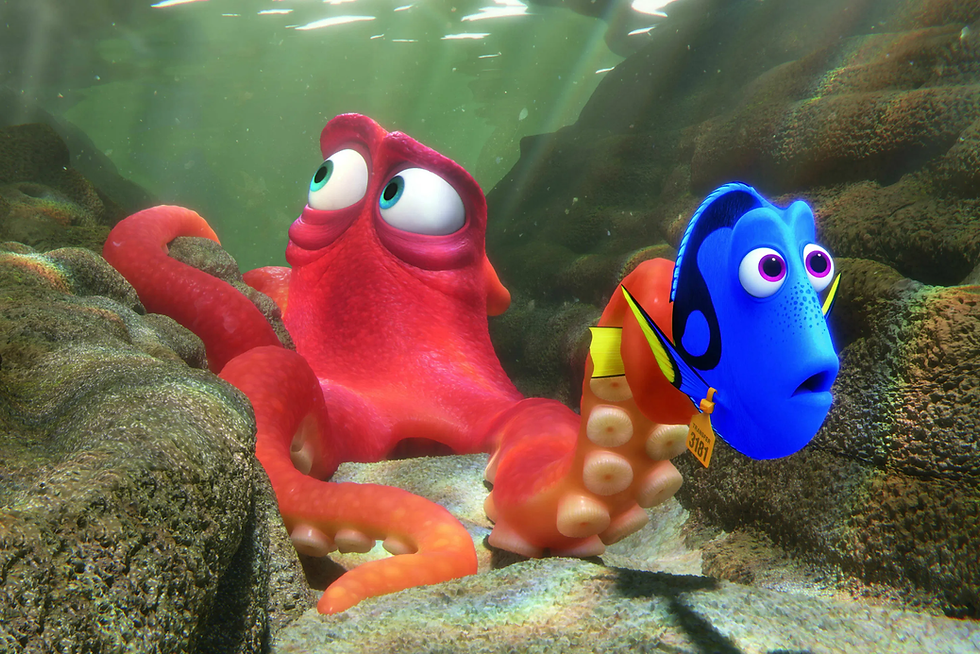
Finding Dory is a great example of how a comedic relief character can carry their own movie. Since Finding Nemo is considered a masterpiece to many, it was a wonder how a sequel could ever try and compete. Luckily, Finding Dory doesn’t try to one-up the original. A fair argument could be made that Dory did not need to be explored further, however, the writers found a way to execute her backstory in a way where the sequel feels natural. What really embodies this skillful execution is how they emphasize the importance of Finding Nemo to her arc. From the moment she loses her family, Dory has been searching aimlessly while her memory continues to dwindle. It’s not until she meets Marlin that she reaches a more sound mental state and her memory begins improving. So it’s clear that without the events of Finding Nemo, Dory would have never remembered her parents in the first place. This is a really nice way to respect the original while adding on to the story.
Overall, Finding Dory has many other strong points. Rather than leaning onto Dory’s silly side, the movie does a good job of balancing her quirks with sincere and dramatic layers of her personality. Thus, they’re able to address undertones of mental illness in a really effective way that isn’t overbearing or tryhard. The only issue with Finding Dory is that it carries itself so well for practically the entire time only to end with a chase scene that is a little ridiculous. At a certain point, when you have whales jumping out of their tanks, otters creating a traffic jam and an octopus hijacking a truck off of a highway into the ocean it just becomes way too much. Regardless, Finding Dory introduces us to new settings, brings back some old faces and makes us fall in love with new ones (most notably Hank the octopus). All while beautifully sticking the landing when Dory is reunited with her parents (spoiler alert, it’ll make you cry). It may have its flaws, but this is a worthy addition to the Pixar pantheon whose emotional beats rival the original.
12. Toy Story 4
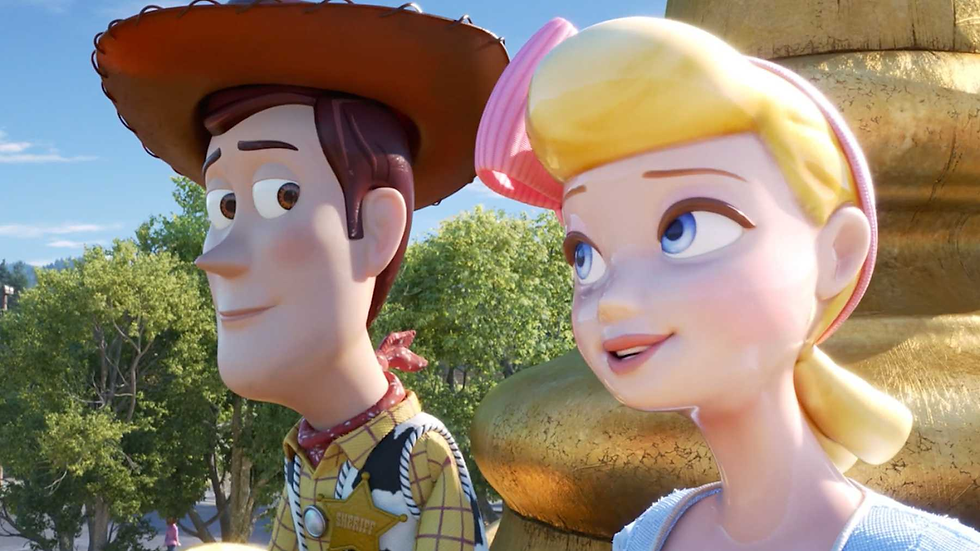
When it was announced that the Toy Story saga would be getting another chapter after the flawless ending of the threequel, I had one question: Why? After the heartwrenching conclusion to the gang’s journey with Andy, there was no way a fourth movie could help the saga. Boy was I wrong. Even after Toy Story 3 made adult men cry like little babies, Toy Story 4 manages to achieve the near impossible of showing us an ending that we didn’t know we needed. Specifically Woody’s ending. Woody’s driving force has always been to show others why you need to be there for your kid no matter what. So while Woody may have followed through until the end of Andy’s story, his journey was not finished. In each Toy Story movie, Pixar has teased the idea of Woody losing Andy, but it never actually happened. So what makes Toy Story 4 so effective is how we see Woody come to terms with a world where he feels as if he has no purpose, and subsequently moves on. Using Bo-Peep as the character to open his eyes felt genuine and dutiful to Woody’s story and it leads to such a well deserved ending for such a beloved character. Ironically though, here is where this installment of the saga pales in comparison to the first three.
While Woody deserved all that he received in Toy Story 4, part of why it feels so different is because it barely features any of the normal gang besides Buzz (even Buzz has his personality reduced to make him a little foolish, albeit pretty funny as well). Characters such as Jessie or Rex or Slinky are just as important to Woody’s character as any other toy. Which is why it’s strange that they didn’t play at least a slightly larger role in the final turn of his arc. Thus, Toy Story 4 loses out on the original group dynamic that made the first three films so iconic. Despite the loss of the original toy squad, however, Toy Story 4 does introduce a whole new group that is arguably just as great. Duke Caboom, Gabby Gabby, Ducky, Bunny and last but not least the amazing Forky all bring their own comedy, fun personality, and underlying themes of loss, failure and fulfillment that is incredibly entertaining to watch. Not to mention they each relate to elements of Woody’s personality and service his development in creative ways. Couple those new characters with perhaps Pixar’s best animation thusfar, and Toy Story 4 rounds out the saga with a justified and tearful goodbye story for Woody. But when all is said and done, this final chapter still feels like an epilogue as opposed to a Toy Story film.
11. The Incredibles

As we’ve reached the midpoint of the ranking, it becomes most difficult. Every choice from here on out could be considered a near perfect if not perfect movie. Starting off this top half is what comic book fans call “the best Fantastic Four movie”. What’s great about The Incredibles is that it’s primarily a family dramedy, in a world of superheroes. Obviously, the Parr family’s superpowers are a huge part of the story, but it’s more than just a superpowered beat em up. At its core, this is a plot about a married couple in a midlife crisis, raising kids in a world where they aren’t allowed to be themselves. This allows for some really interesting development for a superhero team that is actually going through real familial issues; giving them a tangible and fun vibe for viewers to latch onto and revisit.
Another thing this film has is style. With a retro 1960’s design language and the sound of a spy action film thanks to Michael Giacchino’s unbelievable soundtrack, The Incredibles is instantly recognizable on all accounts. Even the side characters help to steal the show and bring something new to the genre. It can really only be chalked up to genius writing for whoever came up with Edna’s “NO CAPES” rant or Frozone’s “WHERE IS MY SUPERSUIT” scene. But a superhero film is largely marked by the strength of its villain. Syndrome may not be the most complex one out there but his incessant motivation and confident fanboy turned psycho genius bravado makes him such a classic memorable bad guy. It’s these simple yet effective elements throughout The Incredibles that really makes it a standout movie of the superhero genre. There really aren’t many flaws within this movie; it’s a classic for sure. Is it as groundbreaking as these next movies though? Not entirely.
10. Toy Story 2

There’s so much good that can be said about each of the Toy Story films, it’s almost hard to condense. With so much great material in each one, there’s never a dull moment. If you were to comment on one thing about Toy Story 2 though, it would be how great of a sequel it is. In all seriousness, this film is the gold standard of how to make an amazing follow-up, and that’s saying something! The first Toy Story movie is practically a perfect film, so following it with something this wholesome is a tough feat; especially when you learn that much of the film was rewritten and almost didn’t make its deadline in time.
Starting off strong, the Buzz Lightyear video game scene is something straight out of a space action thriller. Overall stellar opener. From here the film is filled with one incredible scene after the next. The search through Al’s Toy Barn, Jessie’s heartbreaking backstory (featuring another beautiful song from Randy Newman featuring Sarah McLachlan), the airport escape and lets not forget the most satisfying scene in all of movie history: the Woody repairman scene. The movie fills those scenes with new characters that steal the show and immediately become Toy Story icons. There’s Wheezy, Buster, Second Buzz, Zurg, Mrs. Potato Head, Barbie, Al and of course the famous Roundup Gang. The subplot involving Bullseye, Jessie and Stinky Pete not only expands the lore and wondrousness of the franchise but it builds upon the themes of belonging, purpose, loyalty and abandonment that made the first Toy Story so great, while also really sparking some forward motion for Woody’s arc to be there for Andy at all costs. All tied together with a rescue mission theme, Toy Story 2 isn’t afraid to split up the characters into new and exciting sub groups and situations (plus it’s really great to see Buzz be the one who saves Woody after Woody previously saved him from his demons). Like any great sequel should, this movie develops, expands and adds to what we love without crutching on or diminishing the creativity of the original at all. Without Toy Story 2, the franchise would not be the same one we love so much today. No sequel gets much better than this.
9. Inside Out
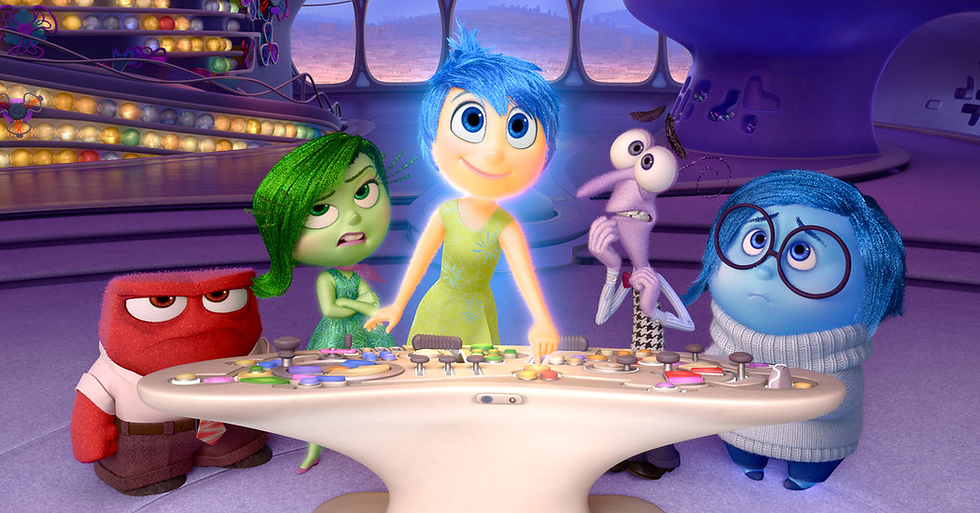
Inside Out is a truly impressive movie. On the surface level, it’s a cute entertaining story with a unique animation style that will certainly catch your eye. However, as you continue to revisit it, it gets better every time. Not only do you discover layers upon layers of detail, brilliant theming, easter eggs and great lines of dialogue, but the entire message and emotional journey will have you reflecting upon your own life differently each time. What is really baffling about this movie though, is how the writers were able to take a premise so deep and complicated and mold it into something so well written and easy to grasp. Overall, the idea of striving for happiness and neglecting sadness is something that anyone can understand; but you would think the main themes of emotional harmony, depression and personality development are too incredibly complex to even map out in a kids movie. In reality, Pixar demonstrates that kids can be shown really emotionally profound motifs without it being cheesy or lazily explained. In simple terms, Inside Out takes a concept that could’ve easily turned out a mess and completely hit it out of the park.
To start off, if you thought you knew the limit of how emotional Pixar films could be, think again. This movie is an emotional rollercoaster...literally. The film constantly tugs on heartstrings such as depression, childhood, family, and lets not forget poor Bing Bong. All jokes aside, it does walk the line of being a depressing movie at times. Nonetheless, the perfectly casted emotions keep it as light and entertaining as possible. Seriously, bravo to whoever cast Phyllis from The Office as Sadness, Mindy Kaling as Disgust and Amy frickin Pohler as Joy. Genius. I couldn’t have picked better voices myself. One thing that is weird about the film is that it’s a little simplistic to say that people are entirely emotionally driven by only joy, sadness, anger, fear and disgust. However, the way the major themes unfold throughout the film cause this plot point to work really well. Having Joy accept that negative emotions such as Sadness and Anger are necessary to be happy in the long run is powerful on so many levels for viewers of all ages. Plus, combining different emotions to create new ones was a nice touch to wrap things together. All in all, the pure spectacle of this movie could keep you in awe for hours on end. Inside Out proves that Pixar reigns supreme when it comes to bringing the mechanics of literally anything to life. Even if that thing is short term memory workers sending a catchy song to get stuck in your head as a prank. This might be Pixar’s most high-brow movie, which is an amazing feat but there’s something to be said about how powerful a more simple theme can be especially in the hands of Pixar.
8. Toy Story 3
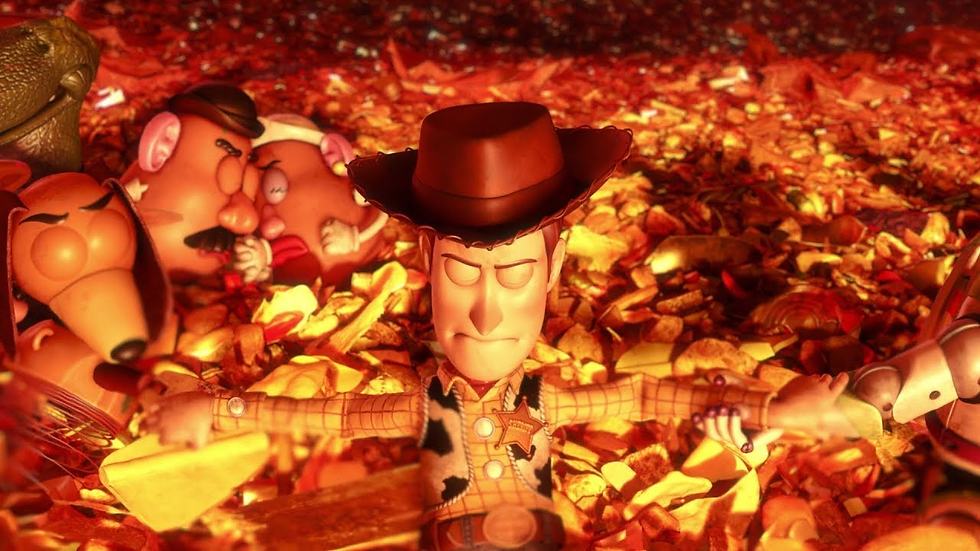
A very fair argument could be made that Toy Story is not only Pixar’s most successful franchise, but also the one people are most emotionally invested in. Each new one seems to find a way to lasso you back in and love the characters ten times more than you did before; and generation after generation has grown up loving Woody, Buzz and Jessie. If any of the Toy Story sequels showcase this the most, however, it is without a doubt Toy Story 3. Probably Pixar’s most emotional movie, nobody was ready for what Pixar had in store for us. Anybody who saw this in theaters can distinctly recall the sounds of families crying throughout the theater as the credits rolled. It’s truly a testament to a perfect execution and timing by Pixar that rightfully deserved its Best Picture nomination.
Being released 15 years after the original Toy Story, and 11 years after Toy Story 2, the third entry to the toy saga had waited the perfect amount of time. Not only did kids see themselves in Andy growing up, but parents saw themselves in Andy’s mom. By the time Toy Story 3 was released then, those same kids were about to leave or preparing to leave for college. So when Andy says his final goodbye to the toy gang it was like your own kid or your own best friend was leaving you. They really lean on this nostalgia with an awesome opening scene depicting the playtime from the original Toy Story movie as it would look in Andy’s mind. That’s one heaping dose of pretextual emotion.
To add on a second layer of emotional stakes we enter Sunnyside, a rainbow-filled day care center with the underground scene of a torture house. Blending comedy, action, drama and even some slight elements of horror, this plot really goes all in on the prison break genre and tops it off with one of the most twisted Pixar villains there is: Lotso. It contains the perfect amount of Toy Story laughs (thanks to Spanish Buzz and Michael Keaton’s Ken) mixed with scene after scene of torture and suffering that builds emotional investment and keeps you hooked. And as if that wasn’t enough emotional tension for one movie, Pixar had us believing they might do the unspeakable...ending the beloved gang’s journey in an incinerator! THESE CHARACTERS HAVE BEEN THROUGH ENOUGH HELL! WHAT MONSTERS! FRICKIN GENIUS MONSTERS!
From this point up until the credits is essentially what drives this movie to rank 8. The way Toy Story 3 builds upon emotional beats consistently right up until the goodbye Andy scene is masterful and beautiful altogether. They toy with us throughout and it is incredibly effective. Not only do they deliver on closing Andy’s relationship with each individual side character, but they hit the bullseye (wink wink) when Andy says goodbye to Woody. Andy finally speaks out about his appreciation for Woody’s loyalty (something that has been Woody’s number one priority for the entire saga) and selflessly recognizes that other children need Woody more than he does. Undoubtedly the goodbye Andy ending is some of Pixar’s best work and represents the swan song of the franchise. So although it could certainly be ranked higher due to these reasons, the grand effect of Toy Story 3 does rely a bit on nostalgia as opposed to these next seven films whose originality serves them even better.
7. Wall-E

Silent film meets golden age Hollywood meets Sci-Fi action meets conservationist themed love story. Unique has been a common term used throughout this entire ranking but Wall-E is a film that is beyond unique. Not even just unique, this movie is bold; as an animated movie, as a kids movie and as a movie in general. From beginning to end, it’s mind boggling what Pixar was able to accomplish with such an out of the box approach. Talking about a family movie you normally would not think of the words bleak, heavy, dark or dystopian. Yet the entire backdrop of this film rests in a future where a barren Earth has been abandoned by the humans who destroyed it.
So how does Pixar approach this to start off the movie? The first 35 minutes is basically a silent film featuring the innocent and extremely lovable robot Wall-E. Despite the helpless nature of the world, Wall-E represents the glimmer of hope and humanity that still exists. His curiosity with human culture including Rubix-cubes and classic Hollywood movies like “Hello Dolly!” are guaranteed to make you smile every time. Despite all of the things the humans have taken and destroyed, Wall-E finds joy and learns to persistently fight for love when futuristic robot Eve visits Earth. It’s basically a huge tug of war between a sci-fi nightmare wake up call and a nostalgic lovable tribute to human potential. That all being said, if you can showcase beauty in a dystopia with such subtlety and nuance, or make a robot romance so compelling, you’re doing something right.
But it’s not only on Earth where this continues. Wall-E and Eve’s journey to outer space is filled with breathtakingly beautiful animation and even more speechless robots that constantly bring a smile to your face. The dark fate of humans sucking life from the Earth is disturbingly mirrored in man’s future relationship with technology and machines. This again was a bold-ass move to call out the human race as glutinous pigs just as global warming awareness was heating up. It not only doubles up on the conservation theme but it makes Wall-E’s sacrifice for both the society and the robot he loves so much that much more emotional. The only thing that stands out in a weird way about Wall-E is how the humans look like they aren’t animated as well as the rest of the movie. Also, once it gets to the third act, it seems to floor the gas pedal a bit. Nonetheless, Wall-E is a kind of Pixar movie that we will probably never see again. The sheer amount of ambition alone puts it into the top ten and many fail to see it as a significantly underrated symphony of dark, exciting and intriguing sci-fi with the beauty and heart of a Pixar classic.
6. Up

You can’t talk about Up without addressing the infamous opening sequence that details the married life of soulmates Carl and Ellie. Everyone wants to find their soulmate and live out their dreams; and all in one silent montage Pixar sweeps the rug right out from under our feet using only visuals and music just 11 minutes into the film. Slowly but surely the image of Carl and Ellie’s dream adventure that is the backbone of their romantic connection begins to fade. But life has setbacks so you hold out hope for them until Pixar erases seemingly all hope that could ever exist as Ellie passes away. Another tear jerking stroke of GENIUS from Pixar. This gut punch roots itself deep into the entire movie and makes Carl Frederickson’s mission so inspiring and most of all whimsical. When that rainbow sea of balloons carries Carl and Ellie’s house through the sky you can’t help but feel the butterflies in your stomach. With every new creature and moment of peril, you can’t help but be sucked into the mysterious whimsy of Paradise Falls. But Carl and Russell are the dynamic duo that hold this chaos together.
There’s something about having an lonely old man as the main character in an adventure movie that is delightfully odd, in a way where you just want everything to be okay for him. The same goes for his stark opposite, the innocent and equally lonely wilderness explorer Russell. Adding Kevin the exotic bird and Dug the talking dog into the mix makes for a pretty hilarious group, but Up finds most of its strength in how it flips its most memorable quote “Adventure is Out There” on its head. It’s such a nice message to send that no matter your age there is always adventure to be found. However, it’s also pretty mature to say that some adventures need to settle so that new ones can grow. This wraps up so well as Carl’s house makes it to Paradise Falls on its own, fulfilling his promise to Ellie despite recognizing that he needed to move on.
Much of the gravity of this film does lie within the opening sequence, but that’s not a bad thing. In truth, it shows how Pixar can take just a few minutes of overtly mature and depressing film and use it to fuel something overtly wacky and fictional. It’s hard to find a film that wrings out this much emotion without the use of nostalgia, but the fact is that Up doesn’t need nostalgia. It’s strikingly original, relatable, extremely cozy and its animation, imagery, and music just scream classic Pixar.
5. Ratatouille
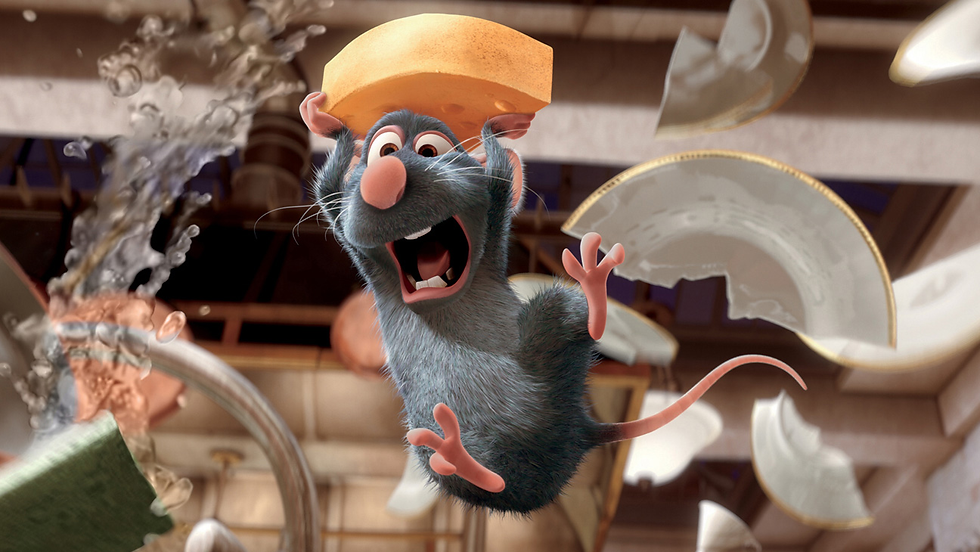
Nobody ever talks about Ratatouille, and that needs to change. One of Pixar’s many strengths lies in their ability to turn a common concept on its head. Ratatouille is one of the best examples of this trick and it results in great comedy, beautiful animation, and a simple theme that really comes full circle. The setting of Paris is the perfect choice to whisk audiences away, entranced by the twinkling skyline, cobblestone streets and food glorious food. Speaking of which, food is ultimately what propels this movie to rank number five. The passion and detail that the filmmakers put into Remy and his love for food is such a strike to the senses that your stomach will come out begging for a European food tour. Plus, it’s through Remy’s passion and his rants that Ratatouille makes you see the true power and complexity in something as simple as food. Which is why it definitely makes sense that adults tend to appreciate this film more than kids. Food is one of the universal joys in life: it can take your mind to another place, it can make you fall in love and it can make you happier than you’ve ever been. However, concepts like these tend to really strike more of a chord with adults, whereas kids are just equally as entertained with a scurrying (and likely disease filled) rat who tugs on a frenchman’s hair to teach him to cook. It’s this blend of simplicity, artistic passion, quirkiness and adult nature that really makes Ratatouille a one of a kind classic. Not to mention the message “anyone can cook” perfectly encapsulates the flavors of these themes to re-emphasize that art (or in this movie’s case “a good cook”) can come from anywhere (including the most unexpected sources). This is what food critic Ego learns: we should enjoy the simple beauties in life instead of shunning and ostracizing them. The end scene showcases this so well and leaves your appetite not overstuffed or wanting more, but completely content. So although younger audiences may not identify with Ratatouille as much as other Pixar films, its passion and heart make it a true sleeper choice that deserves so much more than it gets.
4. Monsters Inc.
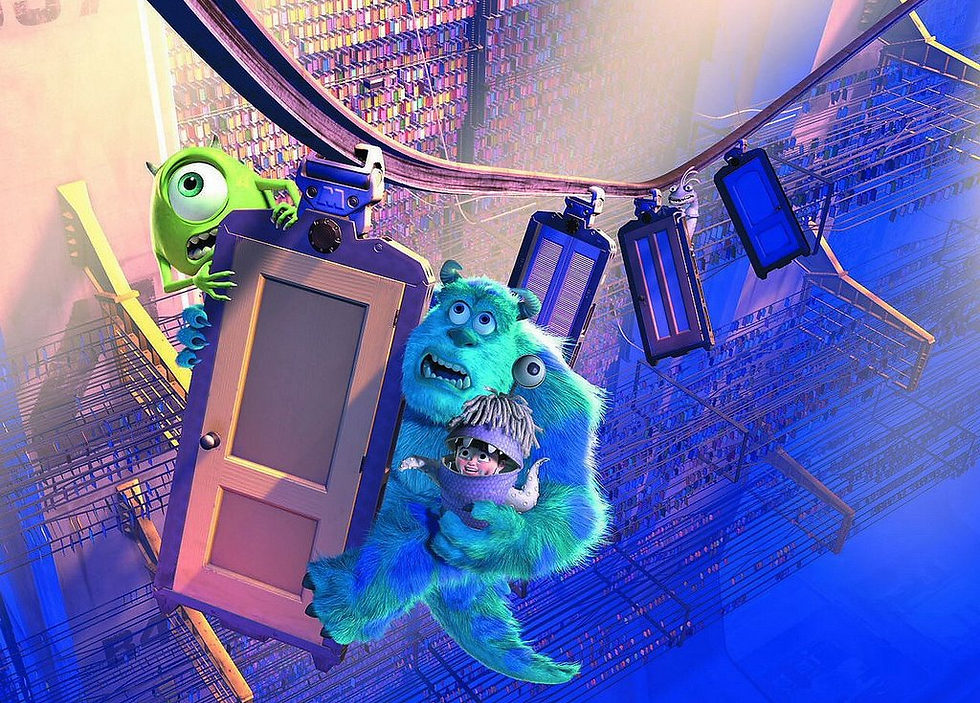
As we reach the top four on this ranking, each one of these could be considered a perfect movie. Starting them off is hands down Pixar’s most inventive to date: Monsters Inc. From its premise, to its plot, to each individual scene, this movie is filled to the brim with clever beats, memorable quotes and creative ideas that make for an all-around enjoyable movie. Monsters have been explored countless times in movies and TV in various forms, but never has anybody been able to make them as heartfelt and human as the residents of Monstropolis. This urban cityscape comically mirrors our own society in a way that’s incredibly entertaining to watch; and at the center of this monster-infested world are Mike and Sully. While Woody and Buzz may have set the standard for dynamic duos, the chemistry between Billy Crystal (Mike) and John Goodman (Sully) is so pure that it arguably improves upon it. Complete with two great villains Randall and Waternoose, the plot is wholefully well rounded to show that even in a civilized monster world there are corporations who wish to exploit others for power. Granted, this movie isn’t really delving into messages that are crazy deep, but the extent that the filmmakers let their imagination run rampant with this concept is still mind blowing 19 years later. There’s not a scene in here that doesn’t make you sit in awe of its subtle comedy or creativity. Whether it’s the 2319 scene, Roz’s voice echoing “I’M WATCHING YOU WAZOWSKI”, or the downright revolutionary door factory climax, the timeless genius of this script will be revered for generations. Still not convinced? Don’t deny you haven’t looked at a door the same way since you first saw this movie.
3. Coco
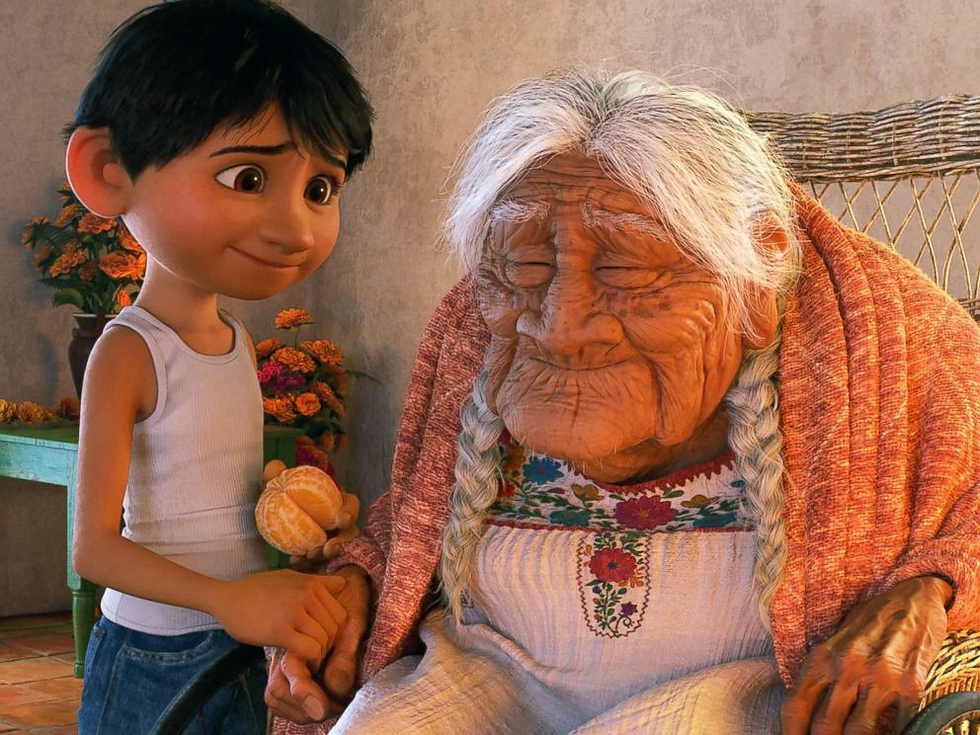
After mastering the worlds of sci-fi, oceans, French kitchens, toy boxes and superheroes, it was only a matter of time before Pixar took a swing at the world of music. If that was all there was to this film’s premise I’m sure it would still be great, but what sends Coco skyrocketing to rank three is how it centers music around familial traditions of Mexican culture. When dealing with any type of foreign culture, there’s always a degree of nitpicking for cultural accuracy and inconsistency. However, you can absolutely tell that Pixar did their homework with this one. From the all-Mexican cast, to the town of Santa Cecilia, to the glimpses of golden age Mexican cinema the culture is seeping out of this film from start to finish. Not to mention the music is consistently vibrant, moving and accurate down to the fingering and strumming patterns of the guitarists. Literally, every song will get stuck in your head and you’ll be completely fine with it. To tie it all together, the use of Día de Los Muertos perfectly captures the importance that Mexican culture places on familial love and respect and opens the door to the remarkably stunning and colorful animation of the land of the dead.
Coco isn’t just a love letter to Mexican culture though. It uses it as a vehicle to address multiple related themes and motifs that anybody of any culture can understand, perfectly exuberating the beauty of Mexican traditions by turning the foreign into the familiar. The way Coco explains death, loss and remembrance is refreshing in that instead of overcomplicating things, it finds its effectiveness in simplicity. Rather than commenting on love for your immediate family, the movie weighs in on the importance of remembering and honoring those who have passed, thus tying the emotional drive of the film directly to the traditions of Día de Los Muertos. This emphasizes the importance of the holiday which is a great way to add weight to the premise. Speaking of which, what Coco does the best is balancing the idea of challenging and respecting these beautiful traditions. Although Miguel manages to change his family’s traditional outlook, he finds a way to do it inadvertently by prioritizing family over his passion for music. This makes the final scene with Mama Coco incredibly moving.
For the musicians out there, this isn’t the only music related theme that will have you glued to the screen. Coco uniquely finds a way to subtly comment on the ruthless and sometimes cursing nature of being a professional musician. Plus, it ties everything together by showing the brightest side of music, which is its ability to save those who are thought to be beyond saving. In the end, this movie is radiant with so much beauty and heart it’ll make you bawl your eyes out ugly cry style no less than three times. Add in some awesome twists and surprise reveals and this wraps up as one of Pixar’s absolute best.
2. Finding Nemo
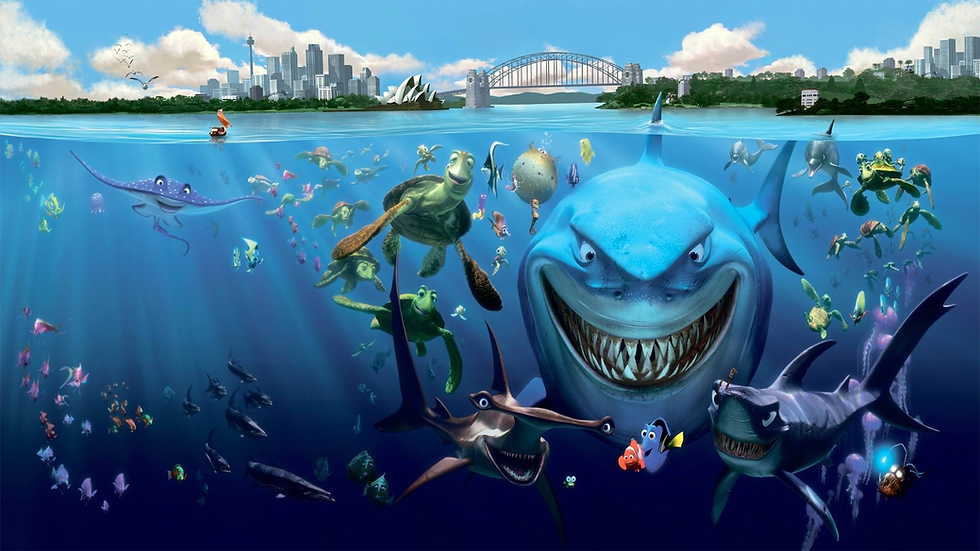
Family is a very common thread woven through Pixar’s tapestry of films. Like many themes in other Pixar movies it is something that is universal and timeless. Finding Nemo is not your average movie about family though. It’s about bravery, trust, and the sheer willpower that love can instill within a person (or fish). You wouldn’t think of it outright, but the ocean is such a perfect setting for this. Both beautifully wondrous and immensely terrifying in its own right, the ocean serves Finding Nemo extremely well. It’s such a well written mirroring of the dangers and wonders that can be found in our own world and main duo Marlin and Dory perfectly embody these polar opposites. Dory represents the beauty of the ocean as she is consistently oblivious, hopeful, and excited by every turn of events. Whereas Marlin represents the fear and paranoia of the ocean. This fear is rightfully justified as Marlin has suffered immense loss, causing him to be an overbearing father. Plus, with hungry sharks, killer angler fish and swarms of jellyfish thrown into the mix, it makes the idea of losing a child that much scarier. But it’s not all glimpses of horror and wild adventure that make Marlin’s journey so compelling; every single new character on their journey leaves a lasting impression with their own unique quirks. From Crush to the pelicans to the tank of fish in the dentist’s office, the movie is filled with comedy and memorable moments. Additionally, it’s rare to find a comedic relief character that gets as much development and worthy attention as Dory does. The little sub messages that she contributes such as “just keep swimming”, and surrendering to trust perfectly adds up to the final fishnet scene. Ultimately showing that trust and fear go hand in hand, and as long as you believe in the ones you love you’ll only become closer, rather than drive them away. Overall, Finding Nemo is one of those rare films that frames itself so well in terms of setting, plot, script, character development and universal themes that nothing can diminish its timeless and legendary nature.
1. Toy Story
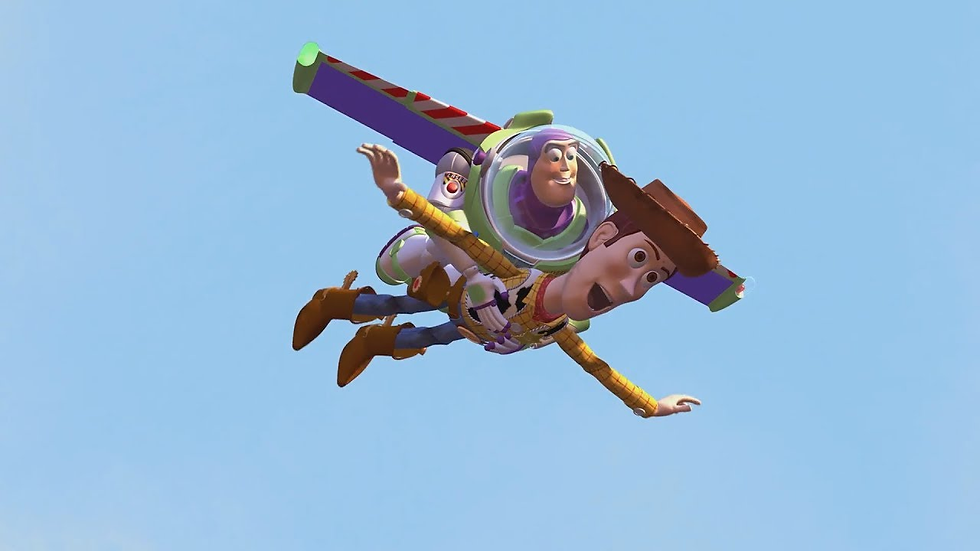
At long last we arrive at the number one ranking out of twenty five years worth of movies. Although many of the films on this list could debatably fill this spot, when it comes down to brass tax, Toy Story deserves to be hailed for the masterpiece that it is: an iconic, revolutionary pioneer of Pixar’s new standard for animated films. Prior to its release, Pixar had been producing short films that many didn’t not envision had much further potential at the time. Being the first full length computer animated film ever, Toy Story not only proved that computer animation could in fact be successful, but it completely took the industry by storm essentially rendering hand-drawn animators in jeopardy of losing their jobs. If you revisit the original Toy Story now, you’ll certainly notice the dated animation style, however, for the most part it still holds up. There’s no denying how groundbreaking this was for its time, and the fact that people are still studying this film just further solidifies its landmark status in the history of modern cinema.
The icon status of Toy Story’s animation is only the tip of the iceberg though. Both for the Toy Story saga and Pixar in general, the success of a franchise can only be marked by how solid its foundation is. With Tom Hanks as Woody the control freak and Tim Allen as Buzz Lightyear the oblivious existential mashup, this film defined the Pixar ingredient of using a strong star powered duo with unlimited chemistry. The cleverness of the plot was shockingly different from slapstick comedies and princess stories of animated past and contained enough depth and heart to keep audiences emotionally invested for over two decades. Not to mention the featuring of numerous catchy Randy Newman songs that enhanced the story without becoming a musical. As a kid you probably loved Toy Story for its bright colors, great action, lovable characters and comedy. As an adult you still love it, but this time for its deep themes of outliving your purpose and existential crises, its fantastic script, and its comedy yet again proving Pixar was not afraid to use sophisticated adult humor in a “kids” movie. All of this comes together in one of Pixar’s best climaxes. Forget adult humor, Woody’s spine chilling revenge on Sid is something you would have never thought you’d see happen to a villain in a kids movie. Furthermore, as Woody and Buzz escape Sid’s rocket only to triumphantly fly through the air yelling Buzz’s iconic catchphrase, that warm content feeling comes right back around. It’s rare that leaps of faith result in a rich stroke of genius like Toy Story. From the very beginning, Pixar’s formula proved to be something that would change people’s lives and for that, credit should be given where credit is due. Out of all of Pixar’s films, the first adventure of Woody and Buzz will likely never die, and will continue to be heralded as a life changing movie to infinity and beyond.
Ranked by Jake Zall
Written by Jake Zall
Edited by Nick Mandala






Comments